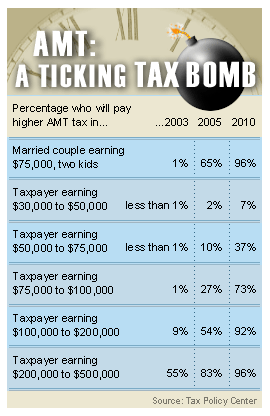NEW YORK (CNN/Money) - So you heard that there are a slew of new tax cuts waiting for you this year and you're ready to pocket that cash.
Not so fast.
You may be among more than 3 million taxpayers who this year will lose out on some or all of those new tax cuts thanks to the Alternative Minimum Tax, or AMT. In fact, those who make between $50,000 and $100,000 and who owe AMT will end up paying between $2,286 and $3,089 more in taxes.
To be sure, the number of such folks is today barely one percent of all filers in that income bracket. But experts warn that the AMT trap is snagging new victims quickly, particularly members of the middle- and upper-middle classes.
By the end of the decade, 33 million taxpayers -- that's one out of every three filers -- will owe AMT, according to the Urban-Brookings Tax Policy Center.
Designed to punish the super rich
Let's start at the beginning with a quick recap. AMT was instituted back in 1970 after members of Congress learned that there were a handful of super-rich people who took advantage of tax laws to avoid paying any tax.

The legislators targeted such tax avoidance by developing a second set of rules for the AMT, which prohibits individuals from claiming certain deductions or "preferences" when they're figuring out how much of their income is taxable. These preferences include things like state and local taxes, real estate taxes or personal exemptions that otherwise take the sting out of tax bills.
The concept behind the AMT may seem fair. But the trouble is that because of inflation, it's hitting middle and upper-middle class people more than ever.
Specifically, people's incomes have grown since 1970 but the AMT doesn't account for that. Now, it's a potential time bomb for millions more Americans than its initial proponents ever imagined.
How can you tell if you'll get hit? There's no quick answer.
The AMT lessens your ability to claim itemized deductions in favor of one big exemption. So those most at risk are taxpayers who claim multiple deductions and exemptions.
It often applies, then, to those who are married with kids; those who pay (and then seek to deduct) a large amount of state and local taxes; people with hefty amounts of other deductions, such as large medical bills or un-reimbursed medical expenses; and those who exercise incentive stock options.
The way to know for sure if you owe is by doing your taxes twice -- once using the 1040, then a second time using the AMT rules (IRS Form 6251). You pay whichever bill is higher.
That means the Bush administration's tax cuts -- which lower the amount filers owe under normal tax rules -- have increased the threat that AMT rules will apply to you. (Because you're supposed to pay the greater of two amounts, if your tax burden falls on the 1040, it increases the chances of the AMT formula being higher.)
If you're tempted to simply ignore the issue, beware. The good folks at the Internal Revenue Service expect individuals to figure out if they owe AMT. In fact, if you don't pay it, you'll get a notice that you owe it, plus penalties for any late payments that are outstanding.
The more the merrier
Any competent accountant will be able to determine if the AMT rules apply to your situation. If you file your return yourself, tax preparation software can make it easier to check whether the AMT applies -- the programs automatically compute your taxes under both schemes.
Say you got hit. Now what?
You can try to figure out why you're paying AMT and if there's any way to rectify the situation. For example, if you live in a high tax state like California (and thereby claiming bigger state and local taxes) you'll likely be stuck, short of moving.
Likewise, if you're claiming lots of personal deductions because you have a big family you'll likely be limited. However, if you have an older child you might, for tax purposes, see if he or she could provide half his own support to file his own tax return (and limit your personal exemptions.)
We're not suggesting you push your darling into the street. You could instead give up to $11,000 (or $22,000 for a married couple) gift tax-free so they could then use it for their share of support.
What about the pile of miscellaneous itemized deductions that got you in trouble? You could deduct part of those expenses in the future -- just enough to keep you safe from AMT.
But your best bet will be to plunk down money and hire a professional tax adviser for advice. If there's really no solution take solace in knowing this: The IRS's taxpayer advocate has called on lawmakers to repeal AMT.
Until then, you'll be in plenty of good company.

|

